#historical food
Text
Wow-Wow Sauce
For @redwineand12gaugeshells... :->
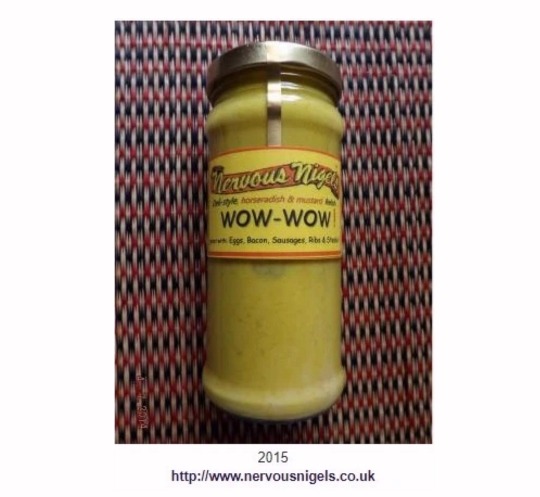
In fact that bottled sauce (and nervousnigels) no longer exists, and in any case its principal ingredients of (squints) horseradish and mustard are way off base.
Wow Wow sauce was meant to go with boiled beef, and since a major ingredient was the meat's broth *, it was more like a pan gravy made at the end of cooking, than something intended to go into / come out of a jar in the preserves cupboard.
* 1817 was well before stock / bouillon cubes, however "portable soup" was a Known Thing and could be a possible alternative. The recipe is specific about using fresh broth, but here's how to make portable soup, because You Never Know.
youtube
Real Wow Wow sauce had no hyphen, no sulphur, no saltpetre and definitely no grated wahoonie, though some "real" ingredients of the Discworld version - mangoes, figs, asafoetida, anchovy - suggest Terry was taking inspiration from labels in his own kitchen, such as those on HP Sauce, Worcestershire Sauce and Yorkshire Relish.
*****
Dr Kitchiner's "The Cook's Oracle" is available online from Gutenberg (the 1833 American adaptation) as well as a PDF of the 1822 UK Third edition from Internet Archive.
Here's his recipe - whose title, for extra interest, includes the original name for what became "Bully Beef":
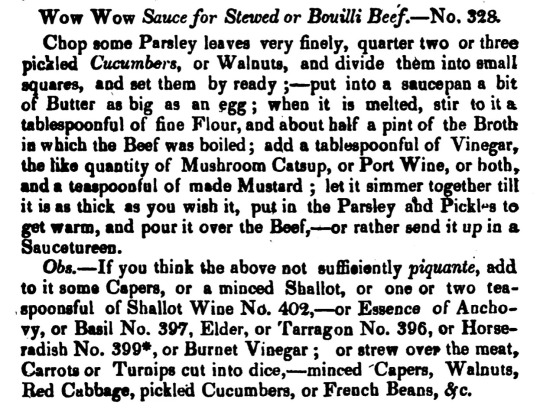
The good doctor's "pickled cucumbers" would have been vinegared like cornichons or gherkins, not brined like dill pickles. In addition, pickled walnuts are easier to find than they used to be; even the Tesco supermarket chain carries them...
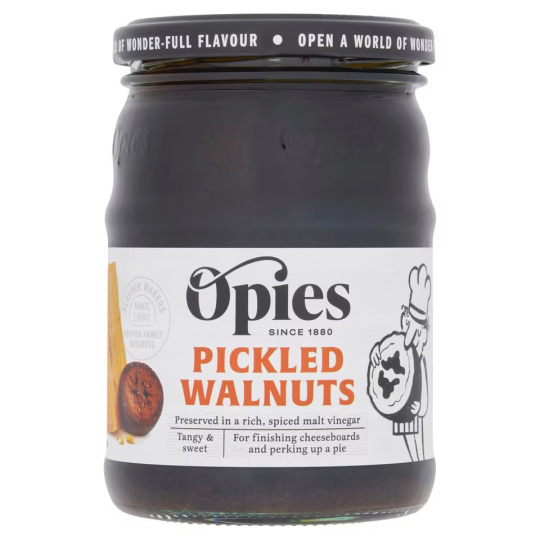
...as well as mushroom ketchup.
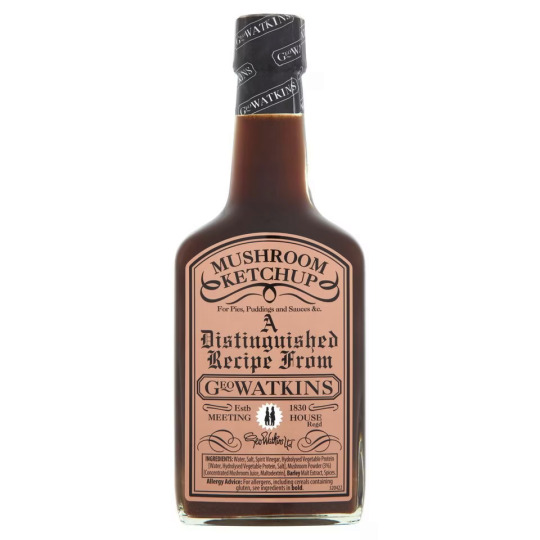
You'd probably still need to make the other herb vinegars and the shallot wine (based on dry sherry), but those are easy, just a matter of steeping the herbs in the liquid for a week or so then straining off and bottling the flavoured fluid.
Another useful ingredient for period cooking is anchovy sauce, which is less, er, emphatic than full-on anchovy essence. You could always scale up if you like the taste.
This also has the advantage of being a pleasant - if you like fishiness - sauce in its own right; try a teaspoonful in a tablespoonful of EV olive oil then tossed with hot pasta. Yum...!

This one's from the same company as the mushroom ketchup and the packing clearly emphasises their "period-ness" (is that a word?) The anchovy sauce is a bit harder to find, but well worth tracking down.
*****
Finally, here's a Youtube short of Wow Wow sauce being made and sampled. It looks entirely acceptable, like a cross between a thin chutney and a thick sauce, and would be, to use Dr Kitchiner's own word, "piquante".
youtube
As a side-note, that by-play with tinned corned beef was a bit pointless, since its texture and flavour are both utterly unlike beef that's been slowly, gently boiled (simmered, TBH) with halved onions, carrots, root veggies etc.
Use shin or silverside; the magic tenderiser for those cheap cuts is Time (or a pressure cooker) - though you can also add a sprig or two of Thyme if you want...
#food and drink#wow wow sauce#wow-wow sauce#Dr Kitchiner#The Cook's Oracle#historical food#GNU Terry Pratchett#Youtube
210 notes
·
View notes
Text
have you ever wondered what people ate in 17th century poland? me neither, but my dad has and since he's a historical reenactor and has reenactor friends, they managed to dig out a cooking book from the period, called Compendium Ferculorum.

this book contains possibly the weirdest recipe i have ever fucking seen, enigmatically called "dish with pancakes", to lull you into a false sense of security. the weirdest thing about it is that it actually tastes really good, and not at all like you would imagine when you initially hear what goes into it.

i understand most of you aren't able to read 17th century polish in a gothic font, so here's the direct transcription:
LXXVI. Potráwá z Naleśnikami
Weźmiy Kapłona álbo Cielęćiny, álbo Báránka, porąb, wymocz, ociągniy, odbierz, poley Rosołem, ułoż másłá, pietruszki, soli, warż, á gdy dowiera, wley rosołu, wley Octu winnego, Cukru, pieprzu, Szafránu, Cynamonu, przywarz.
Zrob Naleśniki, w materią wsyp trochę Száfranu y Cukru, uwarz Ryżu albo Jaieśnicę usmasz, wsyp Száfranu, Rożenkow drybnych, zawiiay tę máteryą w Naleśniki, w ktorą y Cukru przydasz, zrob z Jáiec máteryą, to iest: rozbiy Jáiec, maczay końce tych Naleśnikow w Jáycách rozbitych, puszczay ná gorące másło, a gdy odrętwiesz, daway te potráwę, a Naleśniki ná wierzch kładź, a zalewáiąc day ciepło.
which, loosely "translated" to modern polish, would be:
76. Potrawa z naleśnikami
Weź kurczaka, cielęcinę lub baranka, poćwiartuj, wymocz, oskóruj, odbierz [to nie wiem co mogło oznaczać niestety], zalej rosołem, dołóż masła, pietruszki i soli, gotuj, a gdy zawrze, wlej resztę rosołu, ocet winny, cukier, pieprz, szafran i cynamon, gotuj dalej.
Zrób naleśniki, do ciasta dosyp trochę szafranu i cukru, ugotuj ryż lub usmaż jajecznicę, wsyp szafran, drobne rodzynki i zawiń to nadzienie w naleśniki; w rozbełtanych jajkach z dodatkiem cukru zamocz końce naleśników i podsmaż na maśle, a gdy jajko się zetnie, podawaj potrawę z naleśnikami na górze, zalanymi gorącą zupą.
and in english:
76. Pancake dish
Take a chicken, veal or lamb, quarter it, soak it, skin it, pick it up [this I don't know what it could mean unfortunately], pour broth over it, add butter, parsley and salt, cook it, and when it boils, pour in the rest of the broth, wine vinegar, sugar, black pepper, saffron and cinnamon, continue cooking.
Make pancakes, add a little saffron and sugar to the batter, cook rice or scrambled eggs, add saffron, small raisins and wrap this filling in the pancakes; dip the ends of the pancakes in beaten eggs with added sugar and fry in butter, and when the egg has set, serve the dish with the pancakes on top, drenched in hot soup.
lo and behold, this is what it looks like:
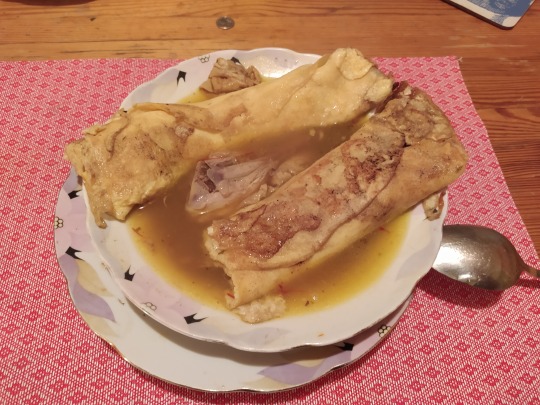
maybe it's not the most appetizing thing in the world, but please trust me when i say that this slaps. this is so fucking good. it has no right of being this good, but it is. why would they eat it back in the day if it wasn't good? this was for high-ranking nobles' kitchens. it had to slap. it had to be over the top and weird.
since the original recipe isn't very descriptive of how much of what you have to add, i'm gonna write it out with as many details as i can for those who aren't as kitchen-savvy and wish to try to make this tasty abomination. unfortunately i forgot to take pictures along the way, so no illustrations, sorry.
Ingredients (for about... 4 servings? I don't know. We had 2 and there was still a lot left):
for the pancakes:
500g of all-purpose flour
4-5 eggs (3 for the batter, 1-2 for later shenanigans)
like a cup of milk
2-3 spoons of sugar (brown sugar would probably be more historically accurate)
saffron (the more the better but watch out, it's expensive as shit)
some water if it turns out too thick
for the broth:
1.5 liters of water
3 stock cubes (if the package says one per 0.5l; otherwise just check what it says)
or you can just make broth from scratch if you want to roleplay a 17th century cook
3-4 chicken drumsticks (or an equivalent amount of veal or lamb)
cinnamon
black pepper
m o r e s a f f r o n
around 120g of butter (half a package if you're polish and know what i'm talking about)
one parsley root
3-4 tablespoons of wine vinegar
a... handful? of sugar. around 2-3 tablespoons, I guess
for the scrambled eggs:
4 eggs (or more; 1 per pancake)
a little bit of milk
1 tablespoon of sugar
e v e n m o r e s a f f r o n if you can afford it
raisins (or dried cranberries or whatever you want that has a similar taste size and texture)
you can also try to make this with rice instead of scrambled eggs. i imagine it can't be that hard.
the steps (there's a lot.):
Sieve the flour and add every other pancake ingredient into it; make sure the saffron is crushed into smaller bits
mix that shit with a hand mixer. it should be the consistency of like, sour cream, so if it's too thick, add a bit of water and check again. it's gotta be generally thick though, make sure it's not too runny (if the consistency is beginning to resemble banana juice, it's too runny already).
heat up the pan, put a little bit of oil on it with a folded paper towel (so you don't burn yourself on accident) and cook the pancakes until they're a bit golden, but not yet brownish in the spots that stick to the pan the most. basically just don't burn them. add a little oil the same way every 2 pancakes.
there's your pancakes, set them aside and move on to other stuff - it's broth time
boil the stock with the parsley root and your meat of choice, but don't add any spices yet, just the fuckton of butter. let it simmer for like an hour. yes, an hour. good soup takes time.
once the time has passed, you can add the spices. notice how i didn't really specify how much of the spices you have to add, and this is because you have to follow your heart and add as much as you can possibly handle eating. no, it's not gonna be too much. add that shit. add 3/4 of a 15g pepper packet. add almost the entire 15 grams of cinnamon. add like a bit of salt, but not a lot this time, just like 2 pinches. ADD THE SAFFRON. add the sugar. add more vinegar than you think would be enough normally. it's gonna boil away anyway.
mix it and let it simmer for even longer. taste it every now and then to see if you can handle it. if a few minutes after doing the dark magic listed above the taste is still very strong, that's good. if it's so strong your throat starts burning, you may be entitled to some more water in there, but if you don't start crying, leave it be. for like another hour.
time for scrambled eggs. rule of the thumb is 1 egg per 1 pancake and 2 pancakes per serving, so if you're cooking for 2, use 4 eggs. easy. add everything that i listed, but if you miss the sugar or the raisins, those can be added after you cook it.
once you have cooked the scrambled eggs, put it on a plate and wash your pan if you don't have another one/don't want to use another one. mix two remaining eggs in a bowl.
put the scrambled eggs with raisins (or whatever you decided to put in there) in your pancakes and roll them as tightly as you can manage. heat up your pan and put some butter on it.
CAREFULLY dip the ends of the pancakes in the mixed eggs and transfer them to the pan with butter. it may be easier to put them on the pan first and pour a little bit of the egg over the ends then, so if you're not sure you can dip them without the entire filling falling out suddenly, do that instead.
fry the pancakes on both sides until the egg is no longer in liquid form.
now, the serving:
pour a ladle of soup into a soup plate
put a piece of your meat in there too if it hasn't disintegrated completely and just started floating around in pieces
put two pancakes in the soup
now you can eat this thing. smacznego :)
I would also like to thank @slavicafire for posting weird old recipes sometimes and inspiring me to take the time to write all of this out :^)
1K notes
·
View notes
Text
I really start thinking about creating some original recipes and just share historical recipes on some different vegetables.
I am right now for health reasons forced to a vegetarian diet and I am honestly very shocked how boring so many of the recipes are - especially as they seem to use the same like five vegetables again and again, rather than using the whole spectrum.
I don't know. Would anyone be interested in that?
18 notes
·
View notes
Text

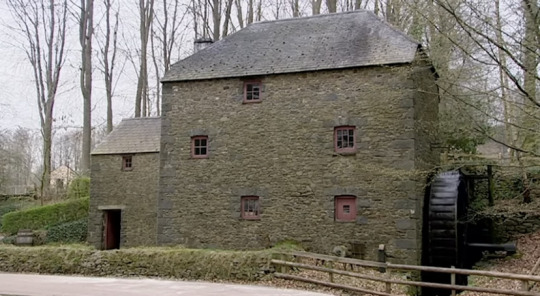
Tales From the Green Valley (2004)
#tales from the green valley#history#welsh#medieval welsh#welsh history#wales#cymru#wales documentary#medieval#medieval history#Jacobite#17th century#17th century house#1600s#1600s fashion#farming#historic aesthetic#historic garden#historic buildings#historical food#historic fashion#archaeology#stuart#english cottage#english countryside#country aesthetic#countryside aesthetic#cottagecore#cottage vibes#cottage garden
45 notes
·
View notes
Text

The Kings feast
As free women of the city, we were invited, and partook in the grand ting this fall. And as custom, the king held a big feast(gille) afterwards for everyone in attendance.
With sausage, minced meat, fried pork, herbal sauces, risen sourdough bread, butter, seasoned flatbread and a stew with this year's harvest of root vegetables and onions.
With plenty of ale to go around, mead, even for the lower tables, and wine for the tables closest to the king's.
A night to remember, and one we will sing about for many years to come. Skål!
7 notes
·
View notes
Text
I made ye olde medieval gingerbread! (Which is literally nothing like modern gingerbread)

It's pretty good! The texture is like sticky, squishier flapjacks. I added some ginger (which wasn't in the recipe) which I didn't really need to do, as they're now too spicy for me 😅
This is definitely better for eating like a sweet instead of a cake (I need to make the pieces smaller), but it's not half bad!
38 notes
·
View notes
Photo


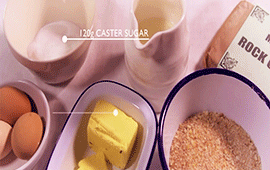

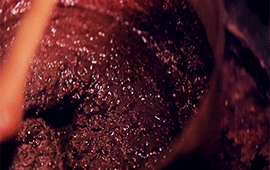



YouTube GIFs || The Victorian Way: Chocolate Pudding
Today, I’m making a treat for the servants — my recipe for steamed chocolate pudding.
#historyedit#the victorian way#mrs crocombe#historical food#english heritage#19th and early 20th#youtube gifs#nanshe's graphics#om nom nom
41 notes
·
View notes
Text
After years and years of reading about people drinking claret-cup in old novels, I finally looked it up today.
Apparently it's punch made with red wine and sparkling water, and I think I'm going to have to spring it on some friends and see if it's any good.
#I did find a recipe that looked promising in a Victorian cookbook#but said cookbook also recommends adding a few drops sulfuric acid to your lemonade#so#historical food#food
3 notes
·
View notes
Text
Concorde Lunch

It is July 19, 1989.
You're on the Concorde. You left New York 20 minutes ago, and you are now flying at twice the speed of sound. You'll be in Paris in three hours.
You heard a new song on your ride to the airport, and you cannot get it out of your head. It's called Wicked Game.
What are you having for lunch? And more importantly, what are you drinking?



Credits | Concorde: Alexander Jonsson via Wikimedia Commons / Menu: New York Public Library.
#bilingual#concorde#airplane#super sonic#aviation#menu#what's on the menu#1980s#1980s vintage#historical food#history#what's for lunch#travel
2 notes
·
View notes
Text
Chicken and waffles

"A lot of people think chicken and waffles are a Southern dish because it uses fried chicken.
Small restaurants in Chicago and California in the 1910s would serve fried chicken and waffles claiming they were authentic Southern dinners though there is no evidence that the South ate chicken and waffles together for dinner. Historians place the origins of the dish from Black people who migrated from the South to the northern states after the Civil War.
Chicken and waffles didn't become popular until the Harlem Renaissance in Harlem, New York in the 1930s at the Wells Supper Club owned by Joseph T. Wells. Musicians leaving work late at night or extremely early in the morning would fill Wells Supper Club and this sweet and savory, breakfast-and-dinner combo kept every belly satisfied."
- Recipe from:
2 notes
·
View notes
Note
I'm curious about the eating pick, how would you compare using it to using a fork?
It's a lot more fiddly - stab not scoop - and having used both a pick and a two-tine fork it surprises me that the three-tine fork with less space for things to fall through (or maybe even something like a modern spork) wasn't an immediate next step, rather than taking more than a century to arrive and then, AFAIK, only for fruit.

Medieval food was mostly eaten with knife-spoon-fingers, and the pick (again AFAIK) was used more like a carving-fork, to hold large pieces in place so they could be cut to spoon- or finger-size, than to convey those pieces to the mouth.
The well-researched "Wolf Hall" series shows Tudor table etiquette, eating with a spoon and with right-hand fingers kept clean by using the napkin worn on left shoulder or forearm.
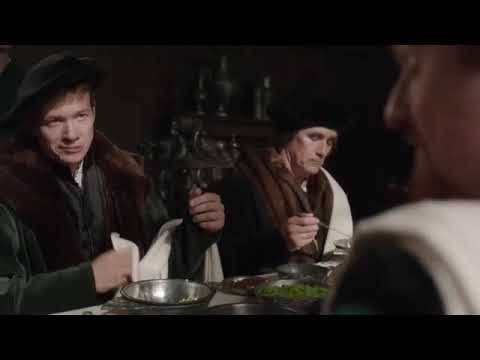
Earlier table manners were similar; there's plenty of reference to hand-washing, napkins and so on.
IMO “The Private Life of Henry VIII” (1933) is probably to blame for the pop-history notion of “historical” dining involving whole chickens pulled apart with both hands and bones thrown over shoulders or onto the floor.
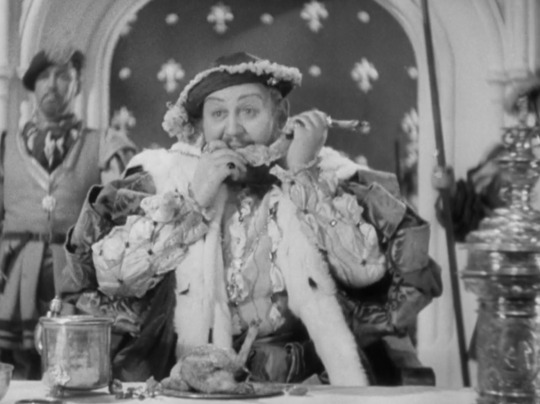
This link is to the full scene on YouTube, where the dialogue proves that it’s being done partly for comedy, and partly to show how nervous Henry made his court.
People in the Middle Ages didn't cut their food with daggers; yes, they'd have worn baselards or rondels or ballock knives because those were part of everyday costume (including women, there's pictorial evidence for it), but they wouldn't have used them at the dinner-table any more than they'd have used a sword.
I wonder sometimes if those who claim daggers were table cutlery know how big a medieval / Renaissance dagger could be, or how out-of-place it would look at a dinner table.
There's plenty of evidence for picks and small eating-knives as personal possessions. Here’s a 14th-century painting and a modern reconstruction of the thing on the belt.

...and another painting, “The Peasant Dance” by Breughel, showing both a big fighting-knife (Messer) and - worn by the red-hosed dancer in the middle - an eating-knife and maybe pick.

The armed man is also showing off (look at his hat!) that he owns a pewter or maybe even silver spoon...
Eating-knife and pick, collectively called "by-tools", could also be slotted into the scabbard of something bigger, such as that Messer in the Breughel painting as recreated by Tod Cutler...


...or a dagger like these Swiss ones...


...whose scabbard ornamentation with human figures proves how they were worn...

- horizontally (usually across the small of the back) so their decoration was right-way-up for proper admiration.

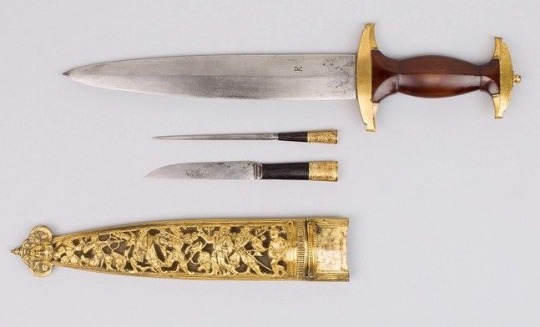
By-tools could be part of even larger weapons, a sword or Kriegsmesser (war-knife) like this one, which belonged to Holy Roman Emperor Maximilian I:


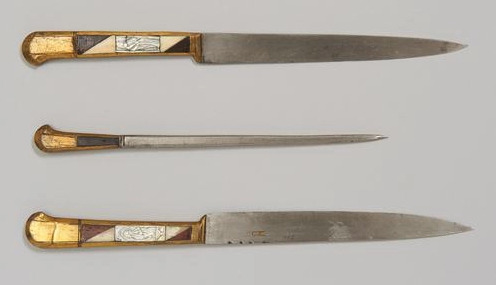
Besides holding down or picking up food, a pick had other functions for which a knife with edges wouldn’t work as well such as an auger to drill holes in leather, or a fid or marlinspike for splicing rope or laces.
By the mid-1500s, people on the cutting edge (hah!) of fashion started to carry the ornate version of that little eating-knife-and-pick sheath; they had a “dining trousse”, personal table cutlery with its own separate case or scabbard, and a REALLY stylish trousse might even include the latest toy, a fork.

But that was often regarded as a pointless (hah!) affectation, because after all, everyone had fingers...
633 notes
·
View notes
Text
reblog and tag ur answer so I can see please :)
#hello first ever poll how did I do#I know this is kind of a wild spread I wanted to pick things that are maybe less accessible today/have more historic precedence I guess ??#I also only picked foods I was already familiar with / was able to find firsthand historical accounts of#cause I didn’t want to fuck anything up lol#for the record I’m between Roman and tang dynasty#anyways#mike makes polls#mike speaks#I also wanted them to be like a normal/ popular meal that would be eaten by most folk regularly#other than the Abraham Lincoln one lmao
14K notes
·
View notes
Text
90s documentaries are wild, I came here to learn about Tudor cooking and suddenly they’re doing a ghost investigation with a dude that looks like this

?????
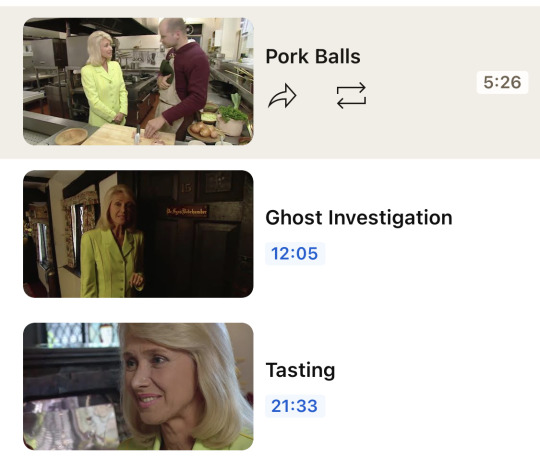
???
#bonus points for the lady in the swaggy green suit#literally what the fuck#history#documentary#historical food#ghost hunting#Tudor
1 note
·
View note
Text


from the Kitāb al-Ṭabīkh (Book of Cookery) written by Ibn Sayyar al-Warraq in the 10th century
2K notes
·
View notes
Text
How to cook in a medieval setting
Alright. As some of the people, who follow me for a longer while know... I do have opinions about cooking in historical settings. For everyone else a bit of backstory: When I was still LARPing, I would usually come to LARP as a camp cook, making somewhat historically accurate food and selling it for ingame coin. As such I know a bit about how to cook with a historical set up. And given I am getting so much into DnD and DnD stories right now, let me share a bit for those who might be interested (for example for stories and such).
🍲Cooking at Home
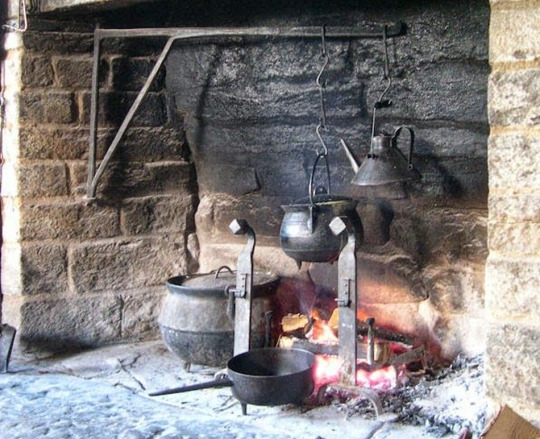
First things first: For the longest time in history most people did not have actual kitchens. Because actual kitchens were rather rare. Most people cooked their food over their one fireplace at home, which looked something like what you see above. There was something made of metal hanging over the fireplace. At times this was on hinges and movable, at times it was set in place. You could hang pots and kettles over it. When it came to pans, people either had a mount they would put over the fire or some kind of grid they could easily put into place there with some sourts of mounts (like the two metal thingies you can see above).
If you have a modern kitchen, you are obviously used to cook on several cooktops (for most people it is probably four of them), while in this historical you obviously only had one fire. Of course, as you can also see in the picture above, you could often put two smaller pots over the flames or put in a pan onto the fire additionally. But yes, the way we cook in modern times is very different.
Because of this a lot of people often ate stews and soups of sort. You could make those in just one pot - and often could eat from the same stew for days. In a lot of taverns the people had an "everything stew" going, which worked on the idea that everyone just brought their food leftovers, which were all put into one pot everyone would eat from.
Now, some alert readers might have also noticed something: What about bread and pastries? If you only have one fireplace and no oven, how did people make bread?
Well, there were usually three different methods for this. The most common one was communal ovens. Often people had one communal oven in a neighborhood. Especially in a village there might just be a communal oven everyone would just put their bread in to bake. (Though often this oven would only be fired up once or twice a week.)
The second version to deal with this some people used was a sort of what we today call a dutch oven. A pot made either of metal or clay with a lit you would put into the hot coals and then put bread or pastries into that, baking it like that.
There was also a version where people just baked bread in pans on the fire, rotating the bread during the baking process. At least some written accounts we have seem to imply. (Never tried this method, though. I have no idea how this might work. My camp bread was mostly done in dutch ovens or as stickbread.)
Keep in mind that the fireplace at home was very important for the people in historical times. Because it was their one source of warmth in the house.
🏕️ Cooking at Camp

Technically speaking cooking at camp is not that different - with the exception of course that you have to drag all your supplies along. And while in Baldur's Gate 3 and most other videogames you can carry around several sets of full-plate armor and several pounds of ingredients so that dear Gale can whip something up... In real life as an adventurer running around you need to make decisions on what to take along.
If you have read Lord of the Rings, you might remember how many people have criticized Sam for actually dragging all his cooking supplies along and how sad he was for not being able to cook for most of the time, because they were very limited in taking ingredients along.
So, yes, if you are an adventurer who is camping out in the open, you will probably need to do a lot of hunting and gathering to eat during your travels. You can take food for a couple of days along, but not for a lot.
A special challenge is of course, that while you can cook food for several days when you are at homes, you do not want to drag along a prepared stew for several days. So usually you will cook in smaller batches.
A lot of people who were journeying would often just take along one or two pots along.
So, what would you eat as an adventurer travelling around while trying to save the world from some evil forces? Well, it would depend on the time of the year of course. You would probably hunt yourself some food. For example hares, birds or squirrels. Mostly small things you can eat within one or two days. You do not want to drag along half a dead deer. In the warm months you might also forrage for all sorts of greens. You also can cook with many sorts of roots. Of course you can also always look into berries and other fruits you might find.
Things you might bring with you might be salt and some spices. A good thing to bring along would be herbs for tea, too, because I can tell you from experience that water you might have gotten from a river does not always taste very well - and springs with fresh water are often not accessible.
Now, other than what you can access the basic ideas of camping fires and cooking with them has not changed in the last few thousand years. While modern people camping usually have a car nearby and hence will have access to a lot of ingredients. But the general ideas of how to build a fire and put a pot over it... has not really changed.
So, yeah.
Just keep in mind that for the most part in historical settings until fairly recently, there was not much terms of proper kitchens. People cooked over an open fire and hence had to get at times ingenius about it.
#dungeons & dragons#baldurs gate 3#lord of the rings#medieval europe#medieval#cooking#medieval cooking#food history#historical settings#history#european history#writing#fantasy#writing resources
1K notes
·
View notes
Photo







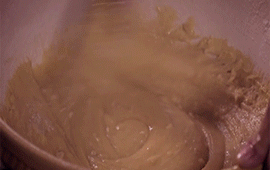
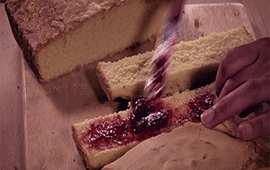

YouTube GIFs || The Victorian Way: Victoria Sandwiches
Lord and Lady Braybooke have guests for afternoon tea, and so I am in the garden looking for flowers to help with the decoration. I’m going to make Victoria Sandwiches; everybody loves Victoria Sandwiches.
#historyedit#mrs crocombe#the victorian way#historical food#english heritage#19th and early 20th#youtube gifs#nanshe's graphics#om nom nom
24 notes
·
View notes